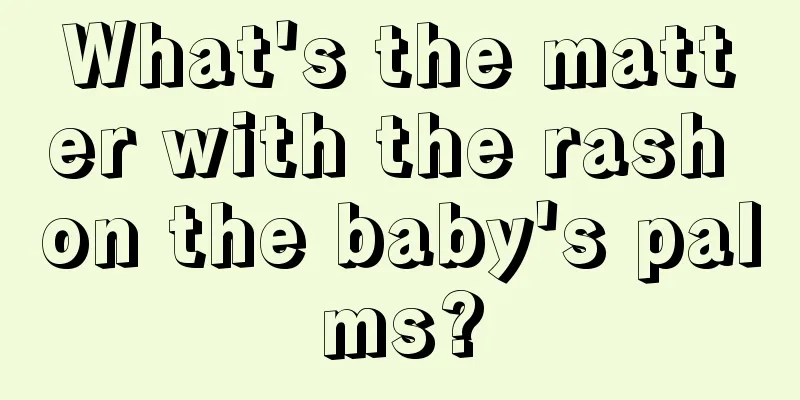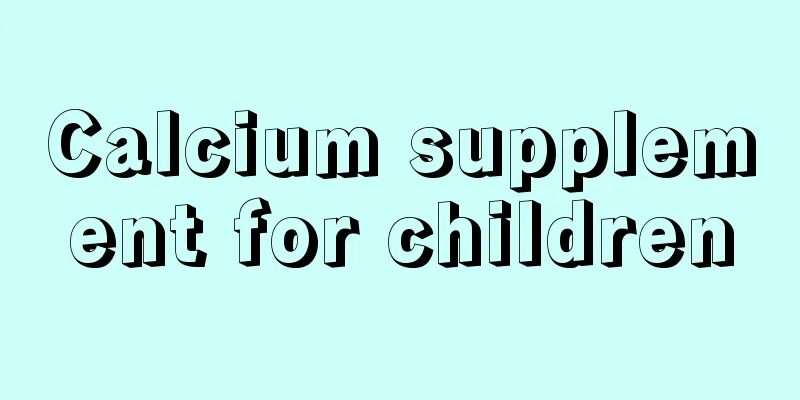How to quickly reduce baby's fever without taking medicine or injections

|
There are actually many treatments for baby's fever that do not require medication or injections and can still achieve good treatment results. So this is what many parents want to know as soon as possible. In order for you to understand as soon as possible how to quickly reduce your baby's fever without medication or injections, please take a look at the detailed introduction below. I hope you can understand and master it as soon as possible. In order to reduce fever quickly without taking medicine or injections, various physical cooling methods should be used correctly and reasonably, such as low-temperature water baths, warm and wet compresses, ice compresses, cold compresses on the head or ice packs on the head, alcohol rub baths, etc. 1. Low-temperature bath: The water temperature is 1°C lower than the child's body temperature. For example, if the fever is 39°C, the water temperature is 38°C. Take off the child's clothes, place the child gently in the basin, and rinse the whole body with water for 3 minutes. After the bath, quickly dry the whole body with a large towel and put on clothes. Measure the temperature once 30 minutes after the bath and record it. During the bathing process, pay attention to the child's complexion, breathing, shivering, etc. If any abnormality is found, bathing should be stopped immediately. 2. Warm and wet compress method: Take a basin of warm water that is 1°C lower than the child's body temperature, put two medium-sized face towels into the water, soak them and wring out a little water (not dripping). Do not wring it too dry, as it will not work if it is too dry. Take off the child's shirt, quickly wrap a wet towel around the chest and back, and wrap the wet towel with a large dry towel. Change the wet towel every 5 to 10 minutes, and continue doing this for 20 to 30 minutes. After applying, dry the chest and back, put on shirt, and cover with a quilt. 3. Ice compress method: Take a piece of ice, put it in a sink or basin, smash the ice into small pieces, put it in the basin to remove the edges and corners, pour the ice into an ice bag (a household hot water bag can also be used) until it is half full or 2/3 full, lay the ice bag flat, squeeze out the air in the bag with your hands, quickly tighten the lid, and at the same time shake the ice bag upside down a few times to check if there is any leakage, wipe the water stains on the outside of the ice bag with a dry towel, and wrap it with cloth. Ice packs should not be placed directly on the skin of the sick child, otherwise it will easily cause frostbite or make the child shiver. They can be placed on the head, armpits, groin, etc. After using ice packs, measure the body temperature once every 30 minutes. If it has dropped below 38.5℃, remove the ice pack. 4. Cold compress on the head or use a cold water bag as a pillow: For cold compress on the head, use a medium-sized towel, soak it under the tap, wring it out slightly (making sure there is no dripping), fold it into four and place it on the forehead. Change it every 5 minutes or so. The cold compress time can be long or short, depending on the degree of drop in body temperature. The method of using a cold water bag as a headrest is the same as the ice compress method. Ice packs and cold water bags should not be placed on the shoulders during the operation. Cold compress on the head or cold water bag on the head are suitable for children with a history of high fever convulsions. The advantage is that it can prevent the body temperature from rising and protect brain cells. 5. Alcohol rub bath: Alcohol rub bath has a strong and fast effect, and it is more effective in cooling down infants and young children. When the high fever reaches above 39.5℃ and there is no antipyretic medicine at home, you may wish to use alcohol rub bath. First, prepare the solution. Use one part 95% alcohol and two parts water, such as 100 ml of 95% alcohol and 200 ml of water. If you don't have 95% alcohol, you can use ordinary liquor. Generally, the alcohol content of liquor is about 65 degrees, that is, add 100 ml of liquor and 136 ml of water. After the liquid is prepared, dip a soft cloth in the prepared alcohol liquid. Do not wring it too dry. Apply from top to bottom and from inside to outside, from the outside of the shoulder to the back of the hand. Then change the cloth and apply from the armpit along the inside of the arm to the palm. Finish wiping one side and then the other side. When wiping the lower limbs, start from the ilium through the inner thigh to the dorsum of the foot, then change the compress and wipe from the groin along the inner thigh to the sole of the foot, then from the lower thigh through the knee to the heel, and finish wiping one side before wiping the other side. When you rub your armpits, groin, soles of feet, palms, etc., you should stay for a while until the skin turns red, this can achieve the effect of reducing fever. Do not use too much force when sponging to avoid scratching the skin. At the same time, you should pay attention to keeping warm. When sponging, only the part to be sponged should be exposed, otherwise you will easily catch a cold. Measure body temperature once half an hour after sponge bath. You can cure your child's hand fever without taking medicine or injections. The above is a comprehensive introduction. I believe many parents have fully understood it. Therefore, for parents, after understanding the above methods, when the child has a fever, you can use the above methods without taking medicine or injections to help the child reduce the fever as soon as possible through physical treatment. |
<<: Physical and medicinal methods to quickly reduce fever in children
>>: What are the best ways to reduce fever in children?
Recommend
Bronchiolitis in infants
Bronchiolitis is a common condition in infants. T...
Characteristics of growth fever
Many children may develop some physiological char...
What to do if your child chokes
Children often choke on milk when they are young....
What to do if your child has a fever of 39 degrees
Colds and fevers are the most common diseases amo...
What are the developmental indicators of a 36-month-old baby?
As we all know, babies already know how to walk a...
What should parents do if their children don’t want to do homework?
Many children love to play, so they are not very ...
What are the dangers of frequent intravenous infusions in children?
Because children have low resistance and are easi...
What are the symptoms of chronic pharyngitis in babies?
When we suffer from pharyngitis, our throat will ...
What foods should children eat when they have a cough?
Children are prone to coughing due to various rea...
How long does it take for the rash to reappear after the fever subsides?
Roseola infantum usually develops rapidly, and mo...
How to properly care for a child with a cold?
Very young infants and young children have very p...
What should I do if my premature baby has bloating?
Babies are more prone to bloating, especially whe...
How long does it usually take for babies to grow teeth?
Nowadays, parents are particularly concerned abou...
What are the reasons for baby tooth loss?
We all know that teeth are used to chew food, but...
What causes peeling of children's fingers?
Many children do not know how to maintain good hy...









